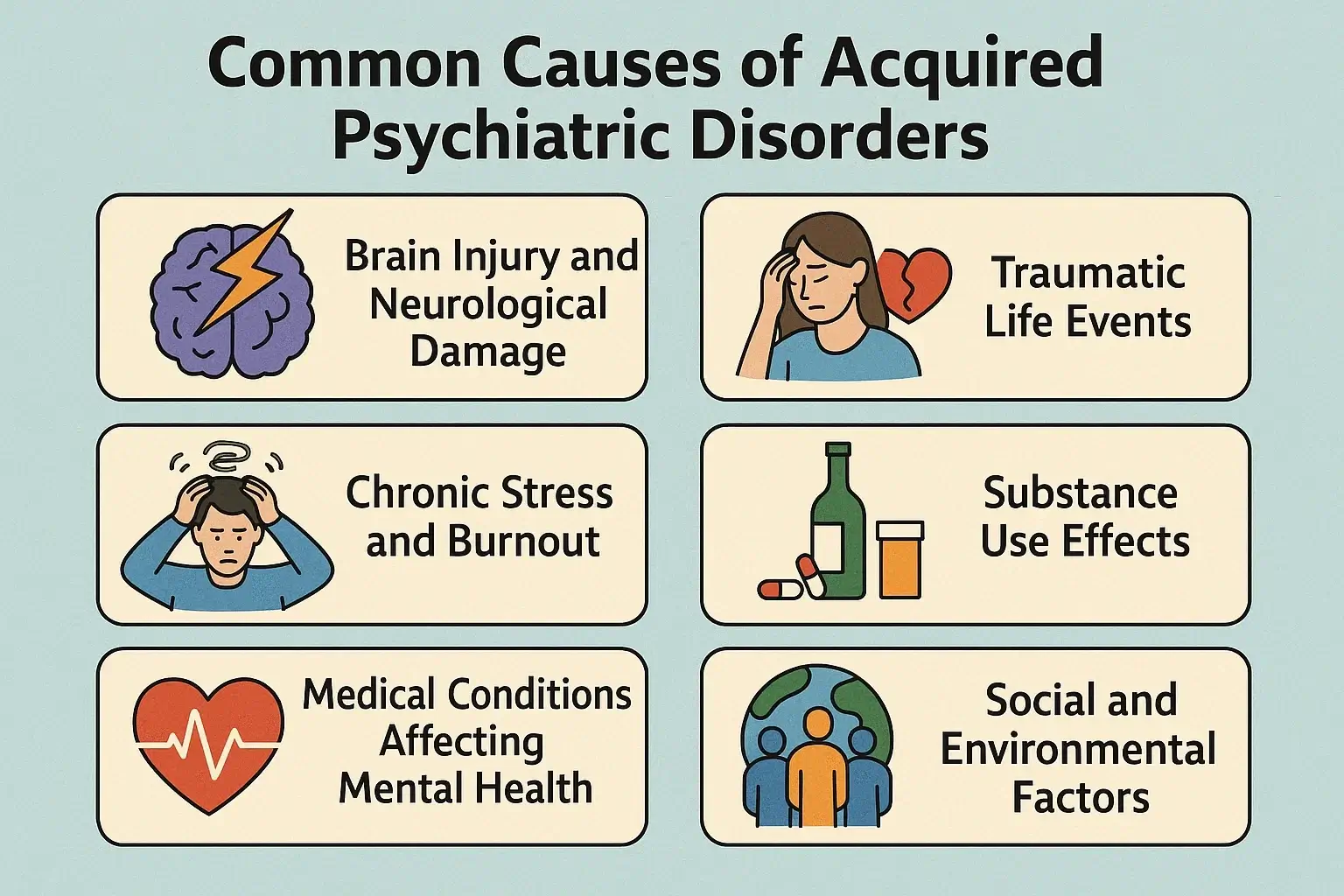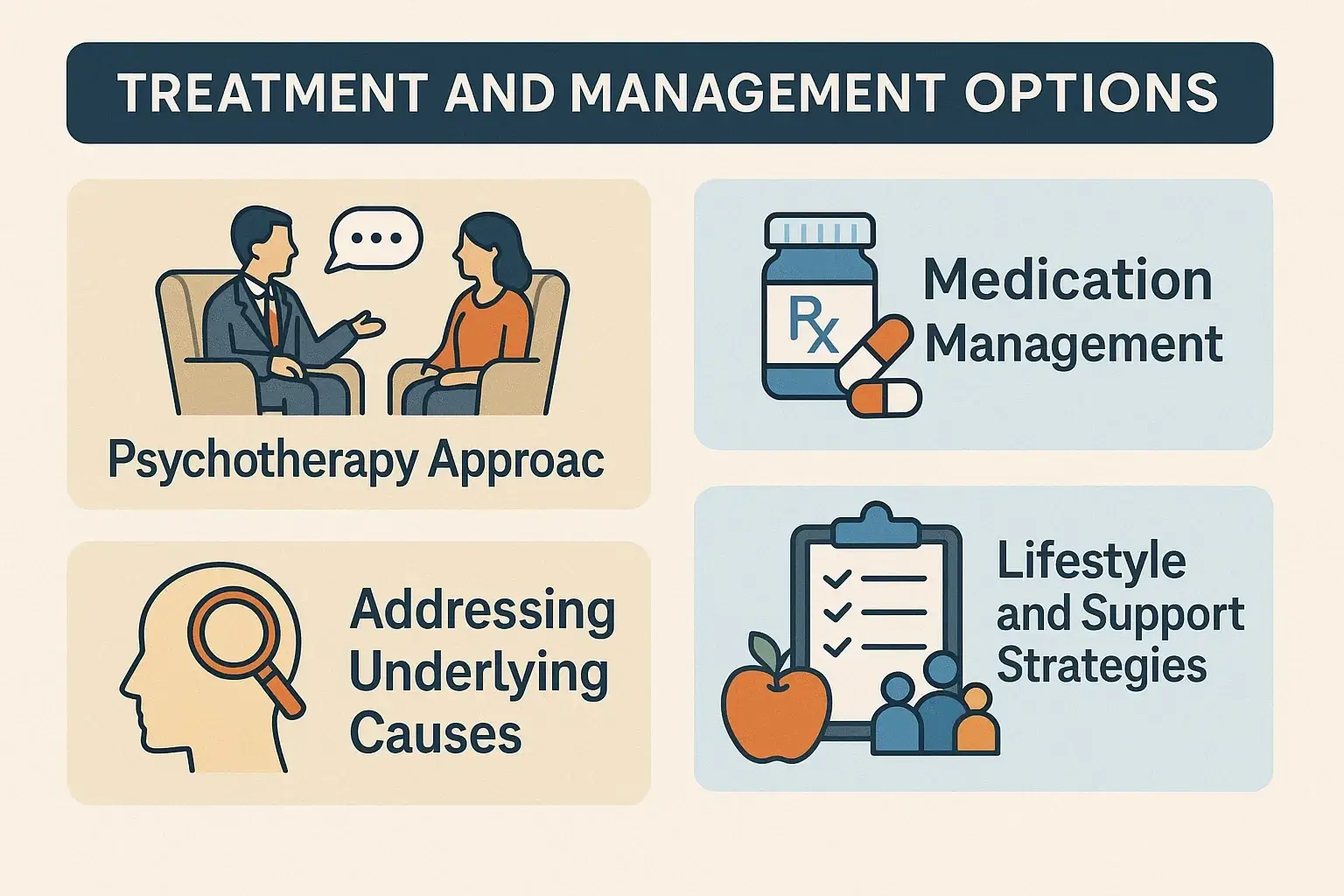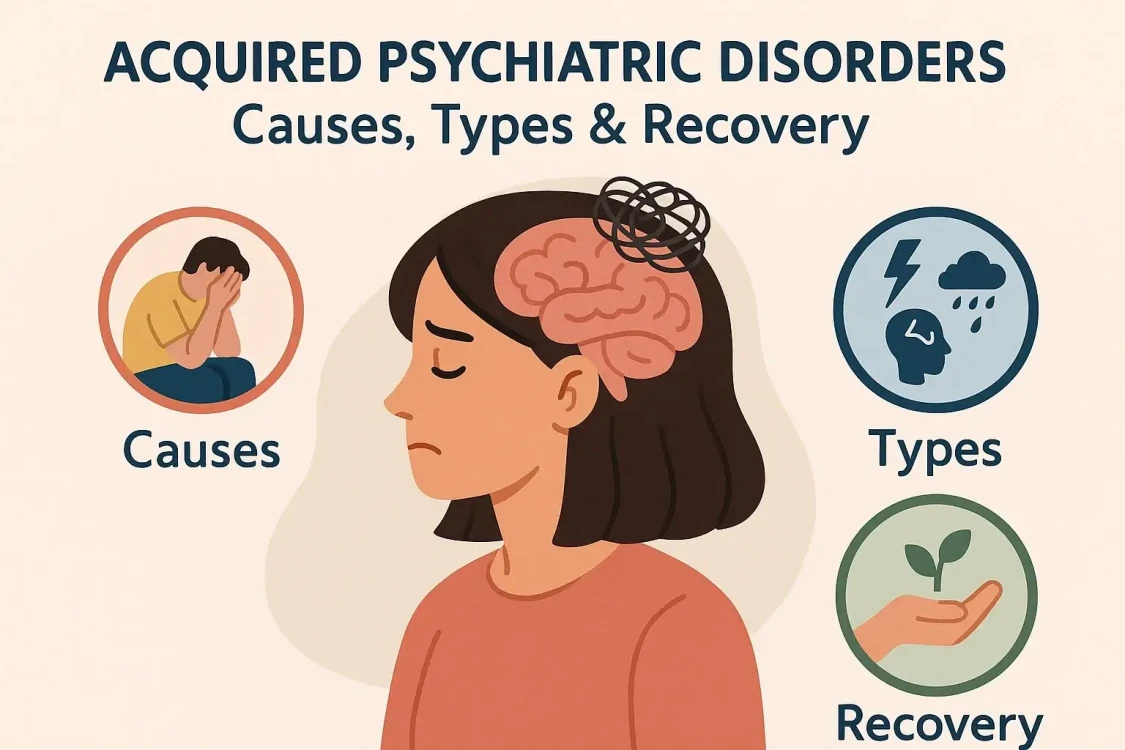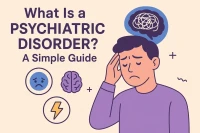Mental health conditions don't always start at birth or come from genetics alone. Many psychiatric disorders arise later in life. They can stem from causes like brain injuries, traumatic events, chronic stress, or medical issues. Understanding acquired psychiatric disorders shows how mental health can change over time. It also explains why treatment may need to focus on physical or environmental causes.
An acquired psychiatric disorder is a mental health issue that develops after birth. It arises from clear external or physical factors instead of mainly from genetics. These conditions can show up quickly after a traumatic event or build up slowly over years of stress. Understanding what caused a psychiatric disorder can guide more effective treatment approaches.
The National Institute of Mental Health states that about 6% of people will experience post-traumatic stress disorder at some point in their lives. Depression following a stroke occurs in 30 to 50 percent of survivors. These numbers show how common acquired psychiatric disorders are. They also explain why understanding these disorders is important.
At Gendrics, mental health education should cover all psychiatric conditions. This includes those that arise from specific causes later in life. This article shares educational information about acquired psychiatric disorders. However, it doesn’t replace professional medical advice. Seeking evaluation from qualified healthcare providers is essential for proper diagnosis and treatment.
What Is an Acquired Psychiatric Disorder?
An acquired psychiatric disorder is a mental health problem that appears later in life. It wasn't there from birth, but comes from specific causes you can often pinpoint.
These causes can include:
- Brain injury from an accident
- Psychological trauma from abuse or combat
- Chronic stress from tough situations
- Substance use changes brain chemistry
- Medical conditions affecting brain function
In medical terms, "acquired" refers to something that develops during a person's life. It is not inherited or present at birth. Several features help distinguish acquired psychiatric disorders. First, there's usually an identifiable onset or triggering event you can point to. Second, these conditions involve changes in brain function that occur after birth. Third, addressing risk factors can sometimes prevent acquired conditions. Treating the underlying causes may make some of them reversible.
This distinction is important. It helps spot risk factors to address. It guides treatment to focus on symptoms and root causes. It also reduces stigma. It shows that disorders arise from specific causes, not personal weakness.
Difference Between Acquired and Congenital Disorders
Congenital psychiatric conditions are present at birth. Genetic factors are often shaped by those passed down from parents. These usually run in families with clear hereditary patterns. Conditions like schizophrenia and some forms of bipolar disorder have strong genetic components.
Acquired psychiatric disorders arise from life events, injuries, or physical changes. They do not mainly result from inherited traits.
Examples are:
- PTSD from combat
- Depression after a stroke
- Substance-induced psychosis
- Personality changes from a traumatic brain injury
- Anxiety disorders due to chronic stress
It can be not very clear. Many conditions involve both genetic risk and environmental triggers working together. Some people may have a genetic risk for depression. This risk often shows up after a traumatic event. Treatment approaches frequently overlap, no matter where they come from. Understanding the causes helps us choose the right interventions.
Common Causes of Acquired Psychiatric Disorders
 Many factors can trigger mental health conditions in healthy individuals.
Many factors can trigger mental health conditions in healthy individuals.
Brain Injury and Neurological Damage
Brain injury from accidents, falls, or violence represents a common cause. Even mild concussions can lead to lasting mood changes. Stroke affects brain regions regulating mood, often causing depression in survivors. Brain tumors or surgical interventions can cause psychiatric symptoms.
Traumatic Life Events
Traumatic life events frequently trigger acquired disorders. Childhood abuse creates lasting brain changes. Combat exposure affects many veterans. Sexual assault, domestic violence, and catastrophic events can trigger lasting mental health changes. Traumatic grief following sudden loss sometimes develops into depression.
Chronic Stress and Burnout
Chronic stress gradually leads to psychiatric disorders even without a single traumatic event. Long-term work stress, relationship issues, and money troubles cause ongoing stress. This stress changes brain chemistry. Cortisol and stress hormones remaining elevated change brain structure over time.
Substance Use Effects
Substance use directly causes psychiatric symptoms through brain chemistry effects. Alcohol-induced depression is common. Stimulants can trigger psychosis. Prescription medications sometimes cause psychiatric side effects. Withdrawal creates severe symptoms requiring medical management.
Medical Conditions Affecting Mental Health
Medical conditions that affect the brain include:
- Infections, such as Lyme disease.
- Autoimmune conditions.
- Hormonal imbalances, like thyroid issues.
- Vitamin deficiencies.
- Chronic illnesses can lead to psychiatric effects.
Social and Environmental Factors
Social factors like isolation, discrimination, major life changes, and cultural displacement can cause chronic stress. This stress raises the risk of mental health issues.
Types of Acquired Psychiatric Disorders
Acquired Mood Disorders
Acquired mood disorders include:
- Post-stroke depression affects nearly half of those who survive a stroke.
- Substance-induced mood disorders from alcohol or drugs.
- Depression is linked to medical conditions, such as thyroid disease or chronic illness.
Acquired Anxiety Disorders
Acquired anxiety disorders include post-traumatic stress disorder (PTSD). It’s the most known anxiety condition that develops after a trauma. Panic disorder sometimes develops after traumatic experiences. Generalized anxiety can emerge following prolonged periods of stress.
Substance-Induced Psychiatric Disorders
Substance-induced psychiatric disorders include:
- Alcohol-induced psychosis and cognitive issues
- Drug-induced conditions from stimulants or cannabis
- Medication-induced symptoms from steroids or other prescriptions
Neurocognitive Disorders
Neurocognitive disorders cover various issues. These include:
- Traumatic brain injuries can cause mild post-concussion syndrome or severe personality changes.
- Dementia, marked by acquired cognitive decline and psychiatric symptoms.
- Delirium, which is sudden confusion due to medical causes.
Personality and Behavioral Changes
Frontal lobe damage can lead to changes in personality and behavior. It often affects impulse control and emotional regulation. Acquired impulse control disorders sometimes develop after brain injury or from neurological conditions.
How Brain Changes Lead to Acquired Disorders
Understanding Neurotransmitters
Your brain uses chemical messengers called neurotransmitters to send signals between nerve cells. These chemicals regulate mood, anxiety, and motivation.
Main neurotransmitters are:
- Serotonin: Helps regulate mood.
- Dopamine: Influences motivation and pleasure.
- Norepinephrine: Involved in stress responses.
- GABA: Offers calming effects.
Brain injury, stress, substances, or illness can disrupt these systems. This leads to mental health symptoms. Depression often involves reduced serotonin activity. Anxiety may involve excessive norepinephrine. Brain chemistry can frequently be rebalanced through treatment.
Key Brain Regions in Mental Health
Key brain regions are:
- Amygdala: Processes fear and emotions.
- Hippocampus: Manages memories and stress regulation.
- Prefrontal Cortex: Controls reasoning and emotional regulation.
Damage or changes in these areas create psychiatric symptoms.
Brain Plasticity and Recovery
Brain plasticity means the brain can change throughout life. This explains both how acquired disorders develop and why recovery is possible. Harmful changes can sometimes be reversed through treatment, rehabilitation, and healthy lifestyle choices.
The Stress Response System
Chronic stress and high cortisol can shrink the hippocampus. This makes the amygdala more reactive, which increases anxiety. The prefrontal cortex's regulatory ability becomes impaired. Long-term stress can lead to lasting symptoms, even after it ends. But these changes are not always permanent.
Diagnosis and Assessment
A proper diagnosis needs a thorough check by skilled healthcare professionals. They can tell apart different conditions and find the root causes.
Initial Evaluation Process
Assessment starts with talking about your current symptoms. We’ll look at when they began, how they affect your life, and any possible triggers. A detailed history is very important. Knowing when symptoms started and what was happening can give key clues about the causes.
Clinical Interview Components
A thorough clinical interview includes:
- Current symptoms and their severity
- Medical history, like health issues and medications
- Life events and trauma history
- Family psychiatric history
- Substance use assessment
Medical Testing and Imaging
Medical testing includes:
- Brain scans for possible brain injury or neurological issues.
- Blood tests to find treatable medical conditions.
- Neuropsychological testing to assess cognitive functions.
- Physical examination.
Diagnostic Classification
Healthcare providers use standardized diagnostic criteria from the DSM-5 to ensure accurate diagnosis. Accurate diagnosis matters because different conditions need different treatments. Misdiagnosis can lead to ineffective or harmful treatment.
Treatment and Management Options
 Effective treatment usually mixes different methods. These methods target both psychiatric symptoms and their underlying causes.
Effective treatment usually mixes different methods. These methods target both psychiatric symptoms and their underlying causes.
Psychotherapy Approaches
Cognitive Behavioral Therapy (CBT) helps find thought patterns that keep symptoms going. It also helps create healthier alternatives. Trauma-focused therapies, including EMDR and prolonged exposure, specifically address trauma-related conditions. Supportive therapy helps people adjust to life changes after brain injury or illness.
Medication Management
Antidepressants help many people with acquired mood disorders. Mood stabilizers and antipsychotics manage acquired bipolar symptoms, psychosis, or severe behavioral problems. Anxiety medications provide symptom control when needed.
Addressing Underlying Causes
Addressing underlying causes is essential. Treating medical conditions, managing substance abuse, and reducing ongoing stress all support recovery. When physical causes are resolved, psychiatric symptoms often improve dramatically.
Lifestyle and Support Strategies
Lifestyle choices can help recovery. These include:
- Managing stress with mindfulness and meditation.
- Exercising regularly for physical and mental health.
- Improving sleep quality.
- Eating well.
All these strategies work together for better recovery.
Cognitive rehabilitation after brain injury helps improve mental functions.
Social support comes from peer groups, family, and community resources. It offers important emotional help. The best treatment combines personalized plans with regular check-ins. It also adjusts as needed for your unique needs.
Living with an Acquired Psychiatric Disorder
Managing long-term conditions means creating daily strategies and keeping hope for recovery.
Understanding and Managing Your Condition
Learning about your specific disorder empowers better self-management. Recognizing triggers and early warning signs enables early intervention.
To work well with healthcare providers, you should:
- Prepare for your appointments.
- Be honest about your progress.
- Actively take part in treatment decisions.
Daily Life and Routine Management
Maintaining treatment consistency, even when feeling better, prevents relapse. Building healthy routines provides structure, supporting mental health. Balancing responsibilities with recovery needs means recognizing limitations while gradually expanding capabilities.
Relationships and Work
Communicating with family and friends about your condition helps them provide appropriate support. Managing work accommodations under disability laws provides protection for maintaining employment. Finding meaningful activities supports mental health and provides purpose.
Emotional Challenges and Building Resilience
Emotional challenges are normal and valid. You might feel grief from changes, anger about the past, or fear of the future. Processing these feelings with support helps you find acceptance and hope. Building different coping strategies helps. Celebrating small wins matters too. Connecting with others who understand supports resilience and recovery.
Prevention and Early Intervention
Not all acquired disorders can be prevented. However, knowing the risk factors can lower the chances of developing these conditions.
Preventing Acquired Disorders
Wearing seatbelts and helmets helps prevent brain injuries. These safety measures cut down on a key cause. Trauma prevention involves creating safer communities and teaching coping skills. Stress management before burnout prevents stress-induced disorders. Substance abuse prevention and early treatment of medical conditions all protect mental health.
Building Protective Factors
Building protective factors helps with mental resilience.
These include:
- strong social connections
- healthy habits
- stress management skills
- access to healthcare.
Recognizing Warning Signs
Watch for early signs like mood changes or behavior shifts after big events. New symptoms after an illness or injury, along with trouble functioning, need quick evaluation. Getting help quickly ensures better outcomes.
Supporting Others
Noticing changes in loved ones and suggesting support can really help them. They might not ask for help on their own.
The Gendrics Perspective
At Gendrics, we focus on complete mental health education. This includes all psychiatric conditions, especially those caused by specific life events. Our approach emphasizes evidence-based information in an accessible language that supports informed healthcare decisions.
Comprehensive Mental Health Resources
Check out our Mental Health Issues Guide. It offers detailed information on different psychiatric conditions for a better understanding. Our Complete Guide to Understanding Anxiety covers anxiety disorders in detail. How to Calm Anxiety Naturally shares evidence-based tips to ease anxiety. Understanding the Difference Between Stress and Anxiety explains when stress turns into an anxiety disorder.
Understanding Psychiatric Disorders
Our article, "What Is a Psychiatric Disorder," describes how these disorders are defined and treated. Men's Mental Health Awareness Month and Women's Mental Health Awareness Month highlight the specific challenges each group encounters. The Guide to Anxiety in Kids shows parents how to tell when a child needs professional help for anxiety.
Mind-Body Connection Resources
Our Prostavive Colibrim Mental Health article explores mind-body connections. It looks at how physical and emotional well-being are linked. The Art Therapy Ideas for Mental Health presents creative approaches to processing trauma. The Cupping Therapy for Anxiety Guide explores alternative wellness approaches as complementary treatments.
Hope and Recovery
Many psychiatric disorders respond well to treatment. Early intervention helps by addressing symptoms and underlying causes. Research continues to advance understanding of brain changes and treatments promoting healing. You're not alone in these challenges. With the right support, recovery is possible.
Conclusion
Acquired psychiatric disorders come from clear causes. These include brain injury, trauma, chronic stress, substance use, and medical illness. Understanding these connections reduces stigma while promoting prevention and early intervention.
The variety includes mood disorders, anxiety, substance issues, cognitive decline, and personality changes. Each requires appropriate professional diagnosis and treatment tailored to symptoms and underlying causes.
Hope comes from understanding that many acquired conditions respond well to treatment. Psychotherapy, medication, and lifestyle changes work together. They help most people improve significantly by addressing underlying causes. Early intervention produces better outcomes.
If you have mental health symptoms due to an injury, trauma, illness, or stress, begin with a professional evaluation. Mental health conditions deserve appropriate treatment and support.
At Gendrics, we support your mental health journey through education and reliable information. Explore our resources on conditions, treatments, and thriving despite mental health challenges. Remember that seeking help demonstrates strength, and recovery is possible.



Comments